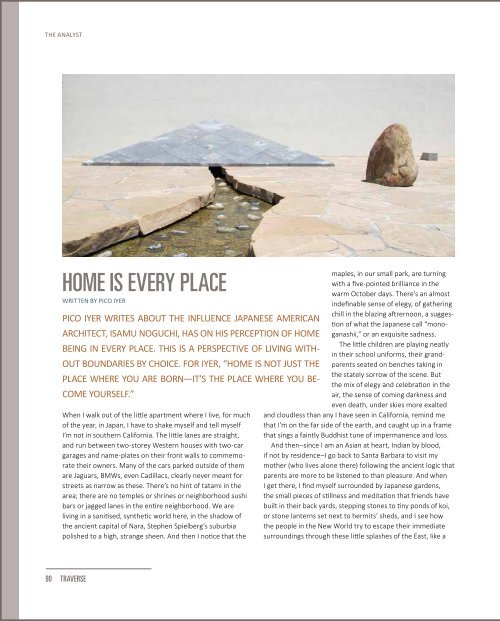TRAVERSE
Issue 1 | STATELESS A student project made at Seattle Central Creative Academy. Not created for profit.
Issue 1 | STATELESS
A student project made at Seattle Central Creative Academy.
Not created for profit.
Create successful ePaper yourself
Turn your PDF publications into a flip-book with our unique Google optimized e-Paper software.
THE ANALYST<br />
HOME IS EVERY PLACE<br />
WRITTEN BY PICO IYER<br />
PICO IYER WRITES ABOUT THE INFLUENCE JAPANESE AMERICAN<br />
ARCHITECT, ISAMU NOGUCHI, HAS ON HIS PERCEPTION OF HOME<br />
BEING IN EVERY PLACE. THIS IS A PERSPECTIVE OF LIVING WITH-<br />
OUT BOUNDARIES BY CHOICE. FOR IYER, “HOME IS NOT JUST THE<br />
PLACE WHERE YOU ARE BORN—IT’S THE PLACE WHERE YOU BE-<br />
COME YOURSELF.”<br />
When I walk out of the little apartment where I live, for much<br />
of the year, in Japan, I have to shake myself and tell myself<br />
I’m not in southern California. The little lanes are straight,<br />
and run between two-storey Western houses with two-car<br />
garages and name-plates on their front walls to commemorate<br />
their owners. Many of the cars parked outside of them<br />
are Jaguars, BMWs, even Cadillacs, clearly never meant for<br />
streets as narrow as these. There’s no hint of tatami in the<br />
area; there are no temples or shrines or neighborhood sushi<br />
bars or jagged lanes in the entire neighborhood. We are<br />
living in a sanitised, synthetic world here, in the shadow of<br />
the ancient capital of Nara, Stephen Spielberg’s suburbia<br />
polished to a high, strange sheen. And then I notice that the<br />
maples, in our small park, are turning<br />
with a five-pointed brilliance in the<br />
warm October days. There’s an almost<br />
indefinable sense of elegy, of gathering<br />
chill in the blazing aftrernoon, a suggestion<br />
of what the Japanese call “monoganashii,”<br />
or an exquisite sadness.<br />
The little children are playing neatly<br />
in their school uniforms, their grandparents<br />
seated on benches taking in<br />
the stately sorrow of the scene. But<br />
the mix of elegy and celebration in the<br />
air, the sense of coming darkness and<br />
even death, under skies more exalted<br />
and cloudless than any I have seen in California, remind me<br />
that I’m on the far side of the earth, and caught up in a frame<br />
that sings a faintly Buddhist tune of impermanence and loss.<br />
And then–since I am an Asian at heart, Indian by blood,<br />
if not by residence–I go back to Santa Barbara to visit my<br />
mother (who lives alone there) following the ancient logic that<br />
parents are more to be listened to than pleasure. And when<br />
I get there, I find myself surrounded by Japanese gardens,<br />
the small pieces of stillness and meditation that friends have<br />
built in their back yards, stepping stones to tiny ponds of koi,<br />
or stone lanterns set next to hermits’ sheds, and I see how<br />
the people in the New World try to escape their immediate<br />
surroundings through these little splashes of the East, like a<br />
90 <strong>TRAVERSE</strong>



